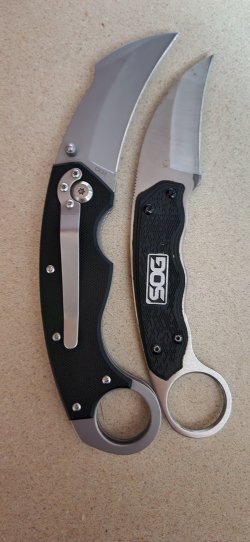I almost always carry a knife. My main purpose for carrying a knife is self-defense. I've been training in Escrima/Arnis since 1987. I practice knife and stick drills almost daily. I also train with a machete sometimes and keep a couple in different locations around the house.
I've seen people get stabbed and die(I grew up near the Mexican border. My dad's mechanic shop was surrounded by Cantinas. I saw lots of guys get stabbed over stupid stuff. I would also go visit my grandpa in Progreso, Mexico and saw people get stabbed there. I went to quinceaneras(girl turning 15 party) in Mexico and Texas border towns and saw people get stabbed there.
I worked in an ER as a Admin Assistant and then EMT and saw patients come in the door who had been stabbed at a park or some kind of party.
Knives are scary and most self-defense encounters are bloody and messy and can mess up your mind because of the intensity of the violence. Some of the worst stabbings I saw were a Hispanic man stabbing a woman or a man over jealousy.
With all that said, I think knowing how to use a knife is an important skill. Because many times a knife is handier than deploying a firearm, especially at closer distances. I believe the Filipino and Indonesian knife arts are some of the best. They employ simple concepts(because when using a knife, simple is best) but they can expand into more complicated aspects(using a knife to hook the head for a ****-kapala movement for example.)
I have had knives pulled on me and got slashed on my arm once. If you've never been cut it messes with your mind (seeing yourself bleed and looking at the cut).
Growing up a good friend of mine was from Mexico and he was very good with a knife. He'd been cut and had some scars. He could have a knife in his hand so fast and be on you before you knew what happened.
I have used the 21 foot rule to show some people how nasty somebody with a knife can be. I always wanted to try a Shock knife. A friend of mine told me great things about training with one. When I teach I use a dull blade or put lots of tape on the blade. We train very slowly. When I train alone I use the blade I carry and my knives are pretty sharp.
I'm a big fan of fixed blade Karambit knives(on the hip or smaller versions you can carry as a neck knife).
One final note, in Escrima we start big and then go small(no jokes please...

). We start with sticks to learn proper movement and footwork, then we go to a stick and knife, then knife, then empty hand(Hubud). Most of the people I have taught one-on-one or in small groups enjoy the training immensely.
I have some students that live 500 miles or farther who still send me emails about the training and I'll sometimes make a basic short video for their eyes only. The videos are also good for me to see what bad habits I've picked up or where I need to improve. There's always room for improvement...




